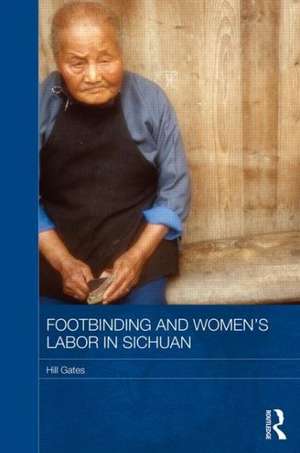Footbinding and Women's Labor in Sichuan: Routledge Contemporary China Series
Autor Hill Gatesen Limba Engleză Hardback – 16 dec 2014
Drawing on extensive fieldwork and interviews with almost 5,000 women, this book examines footbinding as Sichuan women remember it from the final years of the empire and the troubled times before the 1949 revolution. It focuses on two key questions: what motivated parents to maintain this custom, and how significant was girls’ work in China’s final pre-industrial century? In answering these questions, Hill Gates shows how footbinding was a form of labor discipline in the first half of the twentieth century in China, when it was a key institution in a now much-altered political economy. Countering the widely held views surrounding the sexual attractiveness of bound feet to Chinese men, footbinding as an ethnic boundary marker, its role in female hypergamy, and its connection to state imperatives, this book instead presents a compelling argument that footbinding was in fact a crucial means of disciplining of little girls to lives of early and unremitting labor.
This vivid and fascinating study will be of huge interest to students and scholars working across a wide range of fields including Chinese history, oral history, anthropology and gender studies.
| Toate formatele și edițiile | Preț | Express |
|---|---|---|
| Paperback (1) | 436.14 lei 6-8 săpt. | |
| Taylor & Francis – 24 mai 2017 | 436.14 lei 6-8 săpt. | |
| Hardback (1) | 1165.20 lei 6-8 săpt. | |
| Taylor & Francis – 16 dec 2014 | 1165.20 lei 6-8 săpt. |
Din seria Routledge Contemporary China Series
-
 Preț: 326.21 lei
Preț: 326.21 lei -
 Preț: 339.65 lei
Preț: 339.65 lei -
 Preț: 311.41 lei
Preț: 311.41 lei -
 Preț: 280.32 lei
Preț: 280.32 lei -
 Preț: 317.85 lei
Preț: 317.85 lei -
 Preț: 350.12 lei
Preț: 350.12 lei - 18%
 Preț: 1059.45 lei
Preț: 1059.45 lei - 28%
 Preț: 848.57 lei
Preț: 848.57 lei - 18%
 Preț: 1223.21 lei
Preț: 1223.21 lei - 18%
 Preț: 1060.74 lei
Preț: 1060.74 lei -
 Preț: 422.90 lei
Preț: 422.90 lei - 18%
 Preț: 954.20 lei
Preț: 954.20 lei - 18%
 Preț: 1169.66 lei
Preț: 1169.66 lei - 18%
 Preț: 1049.84 lei
Preț: 1049.84 lei - 18%
 Preț: 1217.95 lei
Preț: 1217.95 lei - 18%
 Preț: 1222.16 lei
Preț: 1222.16 lei - 28%
 Preț: 823.99 lei
Preț: 823.99 lei - 18%
 Preț: 1061.93 lei
Preț: 1061.93 lei - 18%
 Preț: 1057.89 lei
Preț: 1057.89 lei - 18%
 Preț: 1112.03 lei
Preț: 1112.03 lei - 18%
 Preț: 1008.02 lei
Preț: 1008.02 lei -
 Preț: 416.82 lei
Preț: 416.82 lei - 25%
 Preț: 823.99 lei
Preț: 823.99 lei - 18%
 Preț: 1114.70 lei
Preț: 1114.70 lei - 15%
 Preț: 702.39 lei
Preț: 702.39 lei - 28%
 Preț: 526.88 lei
Preț: 526.88 lei - 18%
 Preț: 712.13 lei
Preț: 712.13 lei - 18%
 Preț: 1065.06 lei
Preț: 1065.06 lei - 18%
 Preț: 703.09 lei
Preț: 703.09 lei - 18%
 Preț: 1060.87 lei
Preț: 1060.87 lei - 18%
 Preț: 1057.89 lei
Preț: 1057.89 lei - 18%
 Preț: 1062.98 lei
Preț: 1062.98 lei - 18%
 Preț: 1222.16 lei
Preț: 1222.16 lei - 18%
 Preț: 1055.51 lei
Preț: 1055.51 lei -
 Preț: 413.55 lei
Preț: 413.55 lei - 18%
 Preț: 1001.84 lei
Preț: 1001.84 lei -
 Preț: 386.57 lei
Preț: 386.57 lei - 18%
 Preț: 1055.38 lei
Preț: 1055.38 lei - 18%
 Preț: 1053.95 lei
Preț: 1053.95 lei - 18%
 Preț: 1061.57 lei
Preț: 1061.57 lei - 18%
 Preț: 1058.79 lei
Preț: 1058.79 lei - 18%
 Preț: 1109.18 lei
Preț: 1109.18 lei - 18%
 Preț: 1053.47 lei
Preț: 1053.47 lei - 18%
 Preț: 1053.16 lei
Preț: 1053.16 lei - 18%
 Preț: 728.24 lei
Preț: 728.24 lei - 18%
 Preț: 1055.38 lei
Preț: 1055.38 lei - 18%
 Preț: 1165.87 lei
Preț: 1165.87 lei - 18%
 Preț: 1227.38 lei
Preț: 1227.38 lei - 15%
 Preț: 701.45 lei
Preț: 701.45 lei
Preț: 1165.20 lei
Preț vechi: 1420.98 lei
-18% Nou
Puncte Express: 1748
Preț estimativ în valută:
222.99€ • 242.13$ • 187.31£
222.99€ • 242.13$ • 187.31£
Carte tipărită la comandă
Livrare economică 22 aprilie-06 mai
Preluare comenzi: 021 569.72.76
Specificații
ISBN-13: 9780415525923
ISBN-10: 0415525926
Pagini: 260
Ilustrații: 38 black & white illustrations, 14 black & white tables, 15 black & white halftones, 23 black & white line drawings
Dimensiuni: 156 x 234 x 20 mm
Greutate: 0.5 kg
Ediția:1
Editura: Taylor & Francis
Colecția Routledge
Seria Routledge Contemporary China Series
Locul publicării:Oxford, United Kingdom
ISBN-10: 0415525926
Pagini: 260
Ilustrații: 38 black & white illustrations, 14 black & white tables, 15 black & white halftones, 23 black & white line drawings
Dimensiuni: 156 x 234 x 20 mm
Greutate: 0.5 kg
Ediția:1
Editura: Taylor & Francis
Colecția Routledge
Seria Routledge Contemporary China Series
Locul publicării:Oxford, United Kingdom
Public țintă
Postgraduate and UndergraduateCuprins
1. Footbinding in Sichuan, 1854 to 1954 2. Patchworking Sichuan Women’s History across 100 Years 3. Erotic Attraction vs. Mothers-in-law, State Mandates and Early Unbinding 4. Structure, Hypergamy and Footbinding 5. The Life Course 6. Girls and Hidden Work 7. Textiles and Footbinding 8. Hypergendering
Notă biografică
Hill Gates is Professor Emerita in the Department of Sociology and Anthropology and Social Work at Central Michigan University, USA.
Recenzii
"Gates builds her compelling and intriguing argument on a rich set of empirical data gleaned from interviews conducted with elderly women in eastern Sichuan during the early 1990s. I gladly recommend Gates’ book for the boldness of its argument and the relevance of historical materialism." – Limin The, Leiden University
Descriere
Drawing on extensive fieldwork and interviews with almost 5,000 women, this book examines footbinding as Sichuan women remember it from the final years of the empire and the troubled times before the 1949 revolution. It focuses on two key questions: what motivated parents to maintain this custom, and how significant was girls’ work in China’s final pre-industrial century? In answering these questions, Hill Gates shows how footbinding was a form of labor discipline in the first half of the twentieth century in China, when it was a key institution in a now much-altered political economy.
















